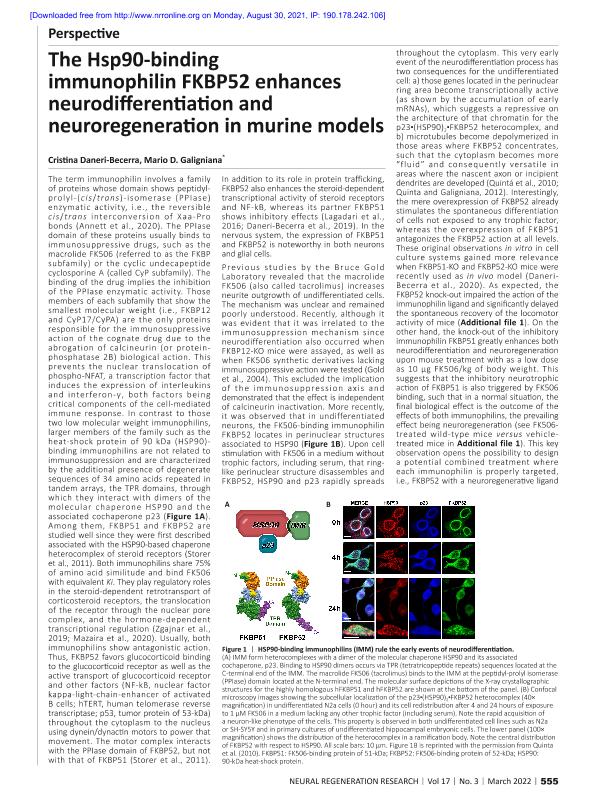Artículo
The Hsp90-binding immunophilin FKBP52 fosters neurodifferentiation and neuroregeneration in murine models
Fecha de publicación:
02/2021
Editorial:
Shenyang Editorial Dept Neural Regeneration Res
Revista:
Neural Regeneration Research
ISSN:
1673-5374
Idioma:
Inglés
Tipo de recurso:
Artículo publicado
Clasificación temática:
Resumen
The term immunophilin involves a family of proteins whose signature domain shows peptidyl-prolyl-(cis/trans)-isomerase (PPIase) enzymatic activity, i.e., the reversible cis/trans interconversion of Xaa-Pro bonds (Erlejman et al., 2013; Annett et al., 2020). The PPIase domain of these proteins usually binds immunosuppressive drugs such as the macrolide FK506 (referred to as the FKBP subfamily) or the cyclic undecapeptide cyclosporine A (called CyP subfamily). The binding of the drug is an event that abrogates the PPIase activity. The smallest members of each subfamily are FKBP12 and CyP17/CyPA are the only proteins responsible for the immunosuppressive action of the cognate drug via calcineurin (or protein-phosphatase 2B) inhibition. This prevents the nuclear translocation of phospho-NFAT, a transcription factor that induces the expression of interleukins and interferon-γ in lymphocytes and are critical components of the cell-mediated immune response. In contrast to those two immunophilins, larger members of the family such as the HSP90-binding immunophilins are not related to immunosuppression and are characterized by the additional presence of degenerate sequences of 34 amino acids repeated in tandem arrays, the TPR domains, through which they interact with the molecular chaperone HSP90. Among them, FKBP51 and FKBP52 are the best studied since they were first described associated to the HSP90-based chaperone heterocomplex of steroid receptors (Storer et al., 2011). Both immunophilins share 75% of amino acid similitude and bind FK506 with equivalent Ki. They play regulatory roles in the steroid-dependent retrotransport of corticosteroid receptors, the translocation of the receptor through the nuclear pore complex, and the hormone-dependent transcriptional regulation (Zgajnar et al., 2019; Mazaira et al., 2020). Usually, both immunophilins show antagonistic action. Thus, FKBP52 favours glucocorticoid binding to the glucocorticoid receptor (GR), the active transport of GR, NF-kB. hTERT and p53 to the nucleus via dynein/dynactin motors, transcriptional activity, telomerase activity, etc., whereas FKBP51 shows inhibitory effects (Lagadari et al., 2016; Daneri-Becerra et al., 2019). In the nervous system, the expression of FKBP51 and FKBP52 is noteworthy in both neurons and glial cells.
Palabras clave:
FKBP52
,
FKBP51
,
Tacrolimus
,
Neurodifferentiation
Archivos asociados
Licencia
Identificadores
Colecciones
Articulos(IBYME)
Articulos de INST.DE BIOLOGIA Y MEDICINA EXPERIMENTAL (I)
Articulos de INST.DE BIOLOGIA Y MEDICINA EXPERIMENTAL (I)
Citación
Daneri Becerra, Cristina del Rosario; Galigniana, Mario Daniel; The Hsp90-binding immunophilin FKBP52 fosters neurodifferentiation and neuroregeneration in murine models; Shenyang Editorial Dept Neural Regeneration Res; Neural Regeneration Research; 17; 3; 2-2021; 405-408
Compartir
Altmétricas




